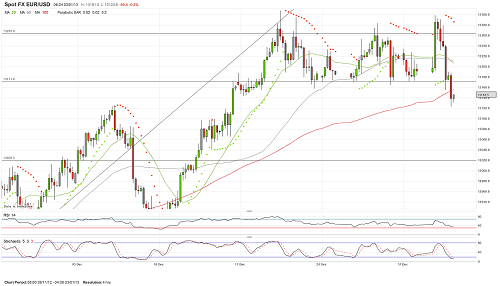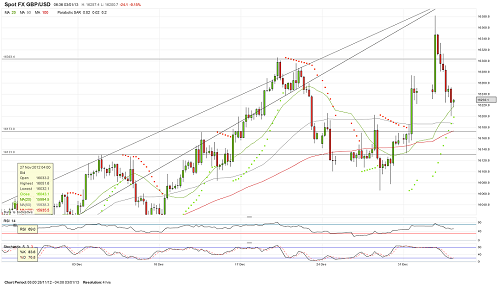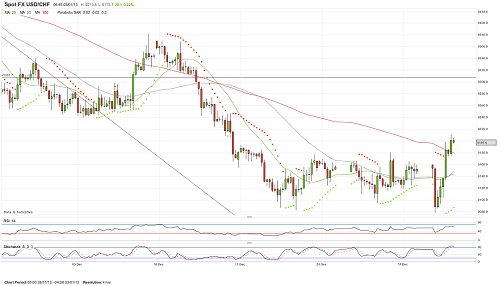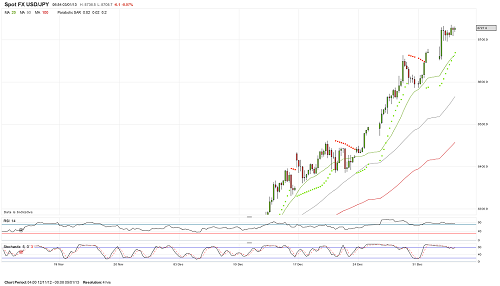‘The other and by far the major defect is that it is the talisman of fear. Fear, Mr Bond, takes gold out of circulation and hoards it against the evil day. In a period of history when every tomorrow may be the evil day, it is fair enough to say that a fat proportion of the gold that is dug out of one corner of the earth is at once buried again in another corner.’ – Auric Goldfinger to James Bond in Ian Fleming’s Goldfinger
We can honestly say we’ve never been a fan of James Bond films. There is a zero percent chance of your editor watching Skyfall…ever.
We’re not sure why. We think it’s because we associate the James Bond series with dull and sleepy Christmas Day and Boxing Day afternoons as a youngster.
But when late last year we got hold of the entire back catalogue of the James Bond books on our Kindle, we started reading them (at the beginning with Casino Royale)…and they had us hooked.
As it happens, on New Year’s Day we finished the seventh book in the series, Goldfinger. It’s where we grabbed the quote you see at the top of this letter.
If you’re not familiar with the book, in short, Auric Goldfinger is a gold smuggler for the Soviets. His ultimate plan is to rob Fort Knox of its gold. Needless to say, James Bond foils the plan. But we won’t give away the full storyline.
As Mr Goldfinger says, gold ‘is the talisman of fear.’ That was true a thousand years ago. It was true in 1959 when Ian Fleming first published Goldfinger. And it is true today…
We’ve got two messages for you. First, ditch the James Bond movies and grab the books instead. We guarantee you’ll never watch another Bond movie again.
Second, yesterday the Dow Jones Industrial Average added 308 points. The day before the blue-chip Aussie index gained 52 points, and yesterday it added 34 points.
But look at what the talisman of fear tells you today?
Despite the surging stock markets and the avoidance of the so-called (yawn) Fiscal Cliff, the talisman of fear is at USD$1,679.
That’s just 12% below the record peak reached in 2011, when the gold price went on a tear leading up to the US debt ceiling crisis and the expected US credit rating cut.
So we ask a simple question: if everything is so great, and if the US is so close to solving its debt and budget problems, why is the talisman of fear barely 12% below its all-time high?
It doesn’t make sense. That’s why, as we wrote yesterday, we love it that the stock market has soared. We’ll take those gains…we’ll take them straight to the bank.
As we’ve always said about gold, we consider it an insurance policy. Just because we didn’t have a car accident yesterday, doesn’t mean we’ll cancel our car insurance policy today.
But there’s another reason why the gold price has held up, and why it will soon hotfoot it higher again. The reason is in Exter’s Prophecy…
Gold is the Foundation of Wealth
Our old pal Dan Denning has told his readers about Exter’s Prophecy in the Daily Reckoning and in his monthly investment advisory, the Denning Report.
The secret to Exter’s Prophecy is in an inverse pyramid. Much like the one below:

The text is difficult to read on this diagram, so we’ll let Dan explain the meaning of the inverse pyramid:
‘The pyramid is made up of all the assets in the financial system. At the bottom is gold, an asset that cannot default.‘Gold is the foundation of the pyramid. It’s real money and bedrock wealth. As you work your way up, the assets slowly change. You go from real money (gold), to paper money (cash), to government bonds.
‘In Exter’s time, the top of the pyramid was risky debt. For example, loans made by the big banks to Latin American countries occupied the top of the pyramid. Today we call it “emerging market debt”. But the point is, anything at the top of the pyramid is actually someone else’s promise to pay you. It’s usually debt, not real, tangible wealth.’
Who was Exter? We’ll leave Dan to explain that in this report. Plus he includes why it’s important for you to understand the significance of Exter’s pyramid.
But put simply, gold is still where it is because everything that’s above gold in Exter’s pyramid still exists.
Will You Live Long Enough to Retire?
There is still paper money in use in every economy on earth.
There is still trillions of dollars-worth of government debt on issue around the world. Even a so-called safe country like Australia has $261.8 billion (more than a quarter of a trillion) in outstanding debt.
And there is still corporate debt, securitised debt, private businesses, real estate…and at the top of the pile, derivatives and unfunded government liabilities.
None of those things – not one – are going away anytime soon.
And as long as they exist, and the more they grow (as they inevitably will), gold becomes more valuable.
Auric Goldfinger says that a ‘fat proportion’ of the world’s mined gold will end up buried in a corner somewhere. Darn right it will. Because there’s another important message in Exter’s pyramid. It’s this…
The pyramid shows more than just the order of safe to risky assets. The pyramid shows the order, or the progression, of the economic collapse. First the derivatives, then the unfunded government liabilities…
(Make no mistake, you won’t get from the government what they’ve promised you, they just haven’t admitted it yet…wait for the government to raise the retirement age to 80 and then 85 within the next five to ten years.)
And so on, until the only asset standing is gold. When will that happen, and how long will it take? The ‘when’ is now. It’s been going on since 2007…if not before.
The ‘how long’ is unknown. It could be this year, the next, or in 10 or 20 years. No one knows. That’s why we recommend holding gold as an insurance policy. But there’s more to it than that. And that’s why we also suggest you take a few minutes to read Dan’s recent report into the secrets of Exter’s Prophecy.
Cheers,
Kris.
From the Port Phillip Publishing Library
Special Report: The Fuse is Lit
Daily Reckoning:
The Great Monetary Devolution Away from the Gold Standard
Money Morning:
Australian Stocks: Still the Best Wealth Builder in Town
Pursuit of Happiness:
Gun Control: Did Obama Shed Tears for These Kids?
Diggers and Drillers:
Five Reasons Why Gold Stocks Are Set to Rebound









